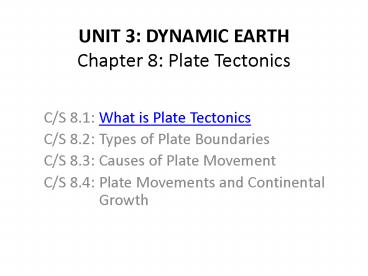UNIT 3: DYNAMIC EARTH Chapter 8: Plate Tectonics - PowerPoint PPT Presentation
1 / 14
Title:
UNIT 3: DYNAMIC EARTH Chapter 8: Plate Tectonics
Description:
C/S 8.2: Types of Plate Boundaries. C/S 8.3: Causes of Plate Movement ... Craton-An expanse of ancient rock at the core of a continent. ... – PowerPoint PPT presentation
Number of Views:400
Avg rating:3.0/5.0
Title: UNIT 3: DYNAMIC EARTH Chapter 8: Plate Tectonics
1
UNIT 3 DYNAMIC EARTHChapter 8 Plate Tectonics
- C/S 8.1 What is Plate Tectonics
- C/S 8.2 Types of Plate Boundaries
- C/S 8.3 Causes of Plate Movement
- C/S 8.4 Plate Movements and Continental
Growth
2
C/S 8.1 What is Plate Tectonics
- Plate Tectonics-The Theory that describes the
formation, movements, and interactions of
lithospheric plates. - Early Ideas about Plate Movements
- 1400s-explorers using maps noted the remarkable
fit of Africa with S. America - 1912-Alfred Wegner proposed the hypothesis of
Continental Drift. It said that continents have
moved or drifted over time. However, it didn't
say how.
3
C/S 8.1 What is Plate Tectonics (cont)
- The Theory of Plate Tectonics
- Says that the continents are embedded on
lithospheric plates that move. Movement Video - Based on a wealth of evidence.
- Explains why earthquakes and volcanoes are found
in clusters. See page 173. - Magnetism helps to support the idea of sea floor
spreading. See page 174. - Mid-Ocean Ridge-A long chain of volcanic
mountains on the ocean floor with a deep central
valley. Younger rocks are found a both sides of
the ridge.
4
Pacific Ring of Fire
5
6
C/S 8.2 Types of Plate Boundaries
- Divergent Boundaries
- A boundary between two lithospheric plates that
are moving apart. - Create rift valleys-deep valleys at the center of
a mid-ocean ridge. - Mid-Atlantic Ridge and East Pacific Rise
- Convergent Boundaries
- A boundary between two plates that are moving
toward each other, or converging. - The boundary is called a Subduction boundary and
creates a deep-sea trench. See page 177. - Creates Volcanoes. Draw picture from page 177.
- Collision boundaries are created when two
continents collide. The Himalayas are a good
example.
7
C/S 8.2 Types of Plate Boundaries (cont)
- Transform Boundaries
- Boundary between two plates that are sliding past
each other. - San Andreas Fault is the best example. See page
178. - study chart on page 179.
- Boundaries in Action
- Continental Growth
8
Boundaries
9
C/S 8.3 Causes of Plate Movement
- The ocean boils under our surfboards!!!
- Mantle Convection
- Heat from Earth's inner and outer core is
transferred through the mantle by this process.
See page 180. - Remember heat rises!
- (Draw picture below)
- Ridge Push Slab Pull
- Cooling, subsiding rock exerts a force on
spreading lithospheric plates that could help
drive their movements. - The heavier plate sinks and then pulls the rest
of his body with him. (I'm Melting)
10
(No Transcript)
11
(No Transcript)
12
C/S 8.4 Plate Movements and Continental Growth
- Reconstructing the Past
- Based on lots of evidence fossils, mountain
belts, magnetic records and rock outcrops. - Plate Tectonics and Pangaea
- Pangaea-Evidence indicates that around 250 mya,
all of the continents were welded into one
landmass. - Gondwana-Group of smaller landmasses that
converged together to create Pangaea. See page
182. - Continued on next slide
13
C/S 8.4 Plate Movements and Continental Growth
(cont.)
- (Cont)
- Pangaea then broke up into smaller continents and
eventually arrived at our current locations.
These continents are still on the move. See page
182 again. - Plate Tectonics and Continental Growth
- Craton-An expanse of ancient rock at the core of
a continent. - Continents have grown and changed shape over
time.
14
C/S 8.4 Plate Movements and Continental Growth
(cont.)
- Sources of Growth Material
- Added material comes from deep-sea sediments,
igneous rock, and river sediments. - Deep-sea sediments are added when an oceanic
plate plunges beneath a continental plate at a
Subduction boundary. Some of the ocean floor
sediment is scarped off the plate and left on the
edge. - Igneous rock-Comes from rising magma, which
creates volcanoes along plate boundaries. Ring
of fire? - River Sediments-Erosion and weathering of earth
material creates new sediments, which build up on
the edge of continents. Why? - Pangea
- Future Plate Movement































